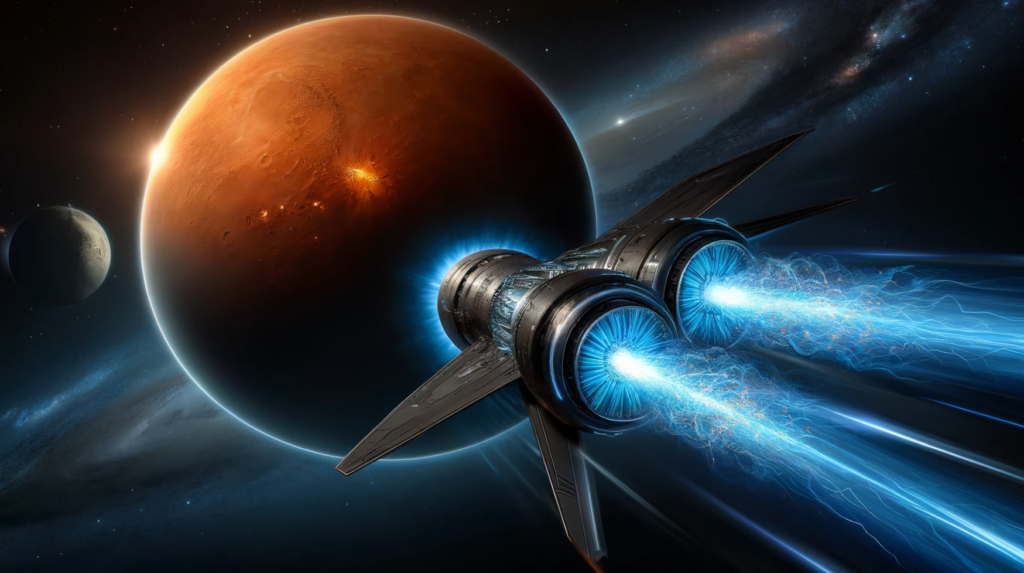A private firm collaborates with NASA to create an innovative rocket aimed at significantly cutting down travel duration in space.

This rocket will feature an engine designed to substantially boost thrust, enhancing both speed and efficiency in space travel.
Thrust, the force propelling a spacecraft, is generated by its propulsion system, typically involving the combustion of gas or liquid fuel to propel the craft forward at high velocities.
Arizona-based Howe Industries is pioneering the development of this new rocket design, termed the Pulsed Plasma Rocket (PPR), currently in its preliminary research phase before moving on to constructing operational engine prototypes.
According to Howe Industries, such rocket technology will be crucial in supporting NASA’s ambitions of returning humans to the moon and potentially venturing to Mars thereafter. NASA also aims to establish a permanent base in space, but the lengthy travel times associated with existing spacecraft pose a significant challenge to these aspirations.
NASA calculates that the moon, on average, is situated about 382,500 kilometres away from Earth, although this distance fluctuates due to the moon’s orbit around our planet. Meanwhile, the average distance from Earth to Mars is approximately 225 million kilometres.
Current estimates from NASA suggest that a journey to Mars using existing spacecraft would require a minimum of 200 days for each leg of the trip. However, the developers of the proposed Pulsed Plasma Rocket claim that their technology could slash this travel time to the Red Planet to approximately two months for each leg of the journey.
Howe Industries asserts that its new rocket design enables the craft to achieve exceptionally high speeds, resulting in more manageable durations for space travel. The development team predicts that its PPR system could generate up to 100,000 Newtons (N) of thrust. In this context, “N” denotes Newtons, a unit of measurement for thrust.
In contrast, NASA has characterized its Space Launch System (SLS) as the most potent rocket ever constructed. According to the agency, the SLS rocket system is anticipated to deliver nearly 53 Newtons of thrust during space travel.

The developers of the Pulsed Plasma Rocket (PPR) assert that beyond a significant increase in thrust, their innovative design also boasts a “specific impulse” rate of 5,000. Specific impulse serves as a measure, in seconds, of the thrust and efficiency levels of rocket engines. A higher specific impulse indicates greater efficiency in the rocket system. In contrast, the SLS rocket exhibits specific impulse rates below 500.
Howe officials have indicated that the PPR is grounded in another plasma-based technology termed pulsed fission fusion. According to NASA, this process involves rapidly compressing plasmas to high pressures to generate thrust. However, the developers argue that the PPR system is more compact, straightforward, and cost-effective to operate.
The team emphasized that such a system is poised to propel significantly heavier spacecraft and facilitate much lengthier journeys to more remote regions of space. Additionally, the envisaged system could streamline the process of outfitting spacecraft with robust shields to safeguard astronauts from Galactic Cosmic Rays, which are highly energetic particles traversing space at nearly the speed of light and can pose health risks to humans when present in substantial quantities.
The Pulsed Plasma Rocket (PPR) project is part of a series of NASA development initiatives that recently secured additional financial support to sustain their progress. These projects are integral components of NASA’s Innovative Advanced Concepts (NIAC) program.
Currently in Phase I of development, the PPR project aims to advance to Phase II pending selection by NASA. Phase II will focus on enhancing the engine’s performance while conducting experiments on key engine systems. The final phase will entail the completion of a spacecraft design tailored for transporting humans to Mars.

